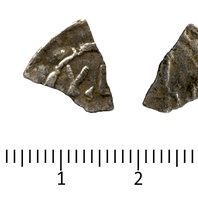
Viking Objects
Arabic Silver Dirham Fragment (SWYOR-1AE8AA)
This silver dirham fragment does not provide enough information to determine the ruler or moneyer but it seems to be from the seventh to ninth century. The dirham was a unit of weight used across North Africa, the Middle East, and Persia, with varying values which also referred to the type of coins used in the Middle East during the Viking Age. These coins were extremely prized possessions not only for their silver value but as a way of displaying one’s wealth and vast trade connections. Millions of Arabic dirhams would have been imported throughout the Viking world and are mostly found in hoards.
Read More
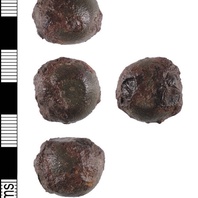
Viking Objects
Globe-Shaped Weight (PUBLIC-D94974)
A globe-shaped copper-alloy weight, with a flat top and bottom each displaying 3 small ring-and-dot motifs. Weights are an important form of evidence for Viking Age commerce and the use of standards across the different economic systems within which Vikings were integrated. Many of the weights discovered, particularly ones in Ireland and those of Arabic type, suggest that a standardized system of weights existed in some areas. These standard weights, alongside standard values of silver, are what allowed the bullion economy of Viking occupied areas to function. A bullion economy was a barter economy that relied on the exchange of set amounts of precious metal in various forms, such as arm-rings or coins, for tradable goods, such as food or textiles. Each merchant would have brought their own set of weights and scales to a transaction to make sure that the trade was conducted fairly.
Read More
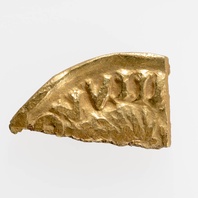
Viking Objects
Quartered Carolingian Gold Solidus (CM.163-2010)
This gold solidus of the Carolingian emperor, Louis the Pious (778-840 CE), was cut into pieces as hack-gold. Unlike the imitation gold solidus from the same era, it has not been cut carefully into quarters. Instead it has been snipped to the right size for weighing. Gold coins were used in the Carolingian empire until it adopted a silver standard.
Read More
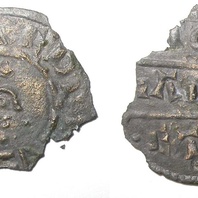
Viking Objects
Coin of Aethelred (1989-58/3395)
A silver penny of Aethelred I of Wessex was found in the mass grave at Repton and minted by a moneyer apparently called Liabinc. The location of minting is unknown. Aethelred I was King of Wessex from 865 until his death in 871. Aethelred’s reign coincided with the arrival of the Viking Great Heathen Army in England and he fought them with little success during their invasion of Wessex which began in 870. After his death, he was succeeded by his youngest brother, Alfred the Great, who carried on the war with the Vikings. Minting coins was a way of controlling the means of exchange within a kingdom and which created a more easily administered standardized system of trade. Moreover, the coins themselves were often used as propaganda, portraying symbols and statements that gave off a desired message. The Vikings later used the minting of coins to legitimize their own rule.
Read More
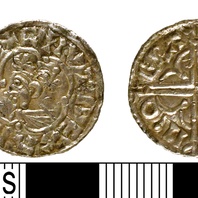
Viking Objects
Coin of Cnut the Great (NARC-5DBF29)
This silver penny was minted in Cambridge for King Cnut the Great, the Danish king who reigned over England from 1016-1035. This particualr coin is is classified as a quatrefoil obverse type. Minting coins was a way of controlling the means of exchange within a kingdom and which created a more easily administered standardized system of trade. Moreover, the coins themselves were often used as propaganda, portaying symbols and statements that gave off a desired message. The Vikings later used the minting of coins to legitimize their own rule.
Read More
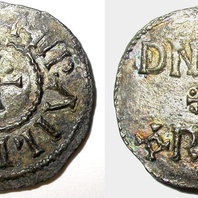
Viking Objects
Viking York Penny (1995-17)
This silver penny was found during demolition work at St Alkmund’s Church in 1967. This type was minted at York for the rulers Sigeferth and Cnut, but this coin has no names, whether of a ruler, a moneyer or a mint. Sigeferth is recorded as being a pirate in Northumbria around 893 and seems to have assumed control after Guthfrith’s death in 895. Cnut is not attested in written sources but Scandinavian tradition places him in Northumbria around the same time. The joint Sigeferth Cnut coins and the sole issues of Cnut were minted around c. 900. This type of penny is known as Mirabilia Fecit from the Latin Cantate Dominum canticum novum, quia mirabilia fecit. Mirabilia fecit means ‘he made it marvellously’ and is the inscription on one side of the coin while the other has the inscription DNS DS REX (‘Dominus Deus rex’ = ‘the lord God almighty is king’).
Read More
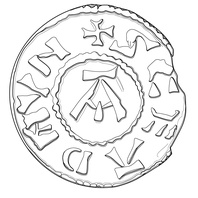
Viking Designs
Drawing of a St Edmund Penny
Between 895 and 915, Scandinavian settlers in East Anglia minted a series of pennies and half pennies with the inscription SCE EADMVND REX (St Edmund the king). These coins appear to have been used widely throughout the Danelaw, and a large number of them were discovered in the Cuerdale Hoard from Lancashire.
Read More
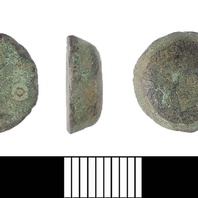
Viking Objects
Circular Weight (LIN-F9FD63)
This copper-alloy weight is decorated with a central punched ring-and-dot motif surrounded by a band of five further ring-and-dot motifs. Weights are an important form of evidence for Viking Age commerce and the use of standards across the different economic systems within which Vikings were integrated. Many of the weights discovered, particularly ones in Ireland and those of Arabic type, suggest that a standardized system of weights existed in some areas. These standard weights, alongside standard values of silver, are what allowed the bullion economy of Viking-occupied areas to function. A bullion economy was a barter economy that relied on the exchange of set amounts of precious metal in various forms, such as arm-rings or coins, for tradeable goods, such as food or textiles. Each merchant would have brought their own set of weights and scales to a transaction to make sure that the trade was conducted fairly.
Read More
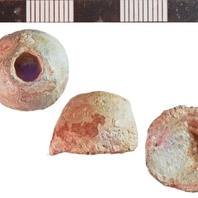
Viking Objects
Lead Weight (NLM-20FC79)
This cast lead weight has an empty apical hole which may have held something at some point. The mass may suggest this to have represented four Viking age units of 4.07gms, as used for silver bullion transactions. It is also possible that this object was used as a gaming piece and thus it could have served a dual purpose. Weights are an important form of evidence for Viking Age commerce and the use of standards across the different economic systems within which Vikings were integrated. Many of the weights discovered, particularly ones in Ireland and those of Arabic type, suggest that a standardized system of weights existed in some areas. These standard weights, alongside standard values of silver, are what allowed the bullion economy of Viking occupied areas to function. A bullion economy was a barter economy that relied on the exchange of set amounts of precious metal in various forms, such as arm-rings or coins, for tradable goods, such as food or textiles. Each merchant would have brought their own set of weights and scales to a transaction to make sure that the trade was conducted fairly.
Read More
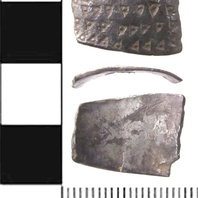
Viking Objects
Silver Arm Ring Fragment (SWYOR-58AFB4)
A fragment of an Early Medieval silver decorated arm ring with triangular punches each with a pellet in the centre. The object may represent hacksilver, but as it is broken rather than cut, this is not certain. Nonetheless, arm rings functioned as both a means of storing wealth as well as putting the wealth and status of the individual on display.
Read More
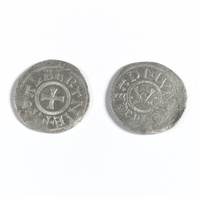
Viking Objects
Reproduction Viking Silver Penny
This reproduction of a Viking silver penny immitates those minited bu the Vikign rulers of York in the tenth century. Viking rulers in the Danelaw eventually took up the Anglo-Saxon practice of minting coins which helped legitimise their authority.
